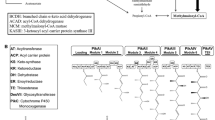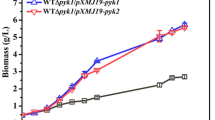Abstract
The objective of this study was to determine the role of midK, which encodes a protein similar to pyruvate carboxylase, in mimosine degradation by Rhizobium sp. strain TAL1145. The midK gene is located downstream of midR in the cluster of genes for mimosine degradation in Rhizobium sp. strain TAL1145. The midK mutants of TAL1145 degraded mimosine slower than the wild-type. These mutants could utilize pyruvate as a source of carbon, indicating that there is another pyruvate carboxylase (pyc) gene in TAL1145. Two classes of clones were isolated from the library of TAL1145 by complementing a pyc mutant of Rhizobium etli, one class contained midK, while the other carried pyc. Both midK and pyc of TAL1145 complemented the midK mutant for mimosine degradation, and also the R. etli pyc mutant for pyruvate utilization. The midK-encoded pyruvate carboxylase was required for an efficient conversion of mimosine into 3-hydroxy-4-pyridone (HP).







Similar content being viewed by others
References
Attwood PV (1995) The structure and the mechanism of action of pyruvate carboxylase. Int J Biochem Cell Biol 27:231–249
Awaya J, Fox P, Borthakur D (2005) pyd genes of Rhizobium sp. strain TAL1145 are required for degradation of 3-hydroxy-4-pyridone, an aromatic intermediate in mimosine metabolism. J Bacteriol 187:4480–4487
Bagdasarian M, Lurz R, Ruckert B, Franklin FC, Frey J, Timmis KN (1981) Specific-purpose plasmid cloning vectors. II. Broad host range, high copy number, RSF1010-derived vectors, and a host-vector system for gene cloning in Pseudomonas. Gene 16:237–247
Beringer JE, Beynon J, Buchanan-Wollaston AV, Johnston AWB (1978) Transfer of the drug resistance transposon Tn5 to Rhizobium. Nature 276:633–634
Borthakur D, Gao X (1996) A 150-megadalton plasmid in Rhizobium etli strain TAL182 contains genes for nodulation competitiveness on Phaseolus vulgaris L. Can J Microbiol 42:903–910
Borthakur D, Soedarjo M (1999) Isolation and characterization of a DNA fragment containing genes for mimosine degradation from Rhizobium sp. strain TAL1145. In: Martinez E, Hernández G (eds) Highlights of nitrogen fixation research. Kluwer/Academic/Plenum, Dordrecht/New York, pp 91–95
Borthakur D, Soedarjo M, Fox PM, Webb DT (2003) The mid genes of Rhizobium sp. strain TAL1145 are required for degradation of mimosine into 3-hydroxy-4-pyridone and are inducible by mimosine. Microbiology 149:537–546
Ditta G, Schmidhauser T, Yakobson E, Lu P, Liang XW, Finlay DR, Guiney D, Helinski DR (1985) Plasmids related to the broad host-range vector, pRK 290, useful for gene cloning and monitoring gene expression. Plasmid 13:149–153
Dunn MF, Mora J (1995) Biochemical and genetic characterization of pyruvate carboxylase in Rhizobium etli and R. tropici. In: Tikhonovich IA, Provorov NA, Romanov VI, Newton WE (eds) Nitrogen fixation: fundamentals and applications. Kluwer Academic Publishers, Dordrecht, p 576
Dunn MF, Encarnacion S, Araiza G, Vargas MC, Davalos A, Peralta H, Mora Y, Mora J (1996) Pyruvate carboxylase from Rhizobium etli: mutant characterization, nucleotide sequence, and physiological role. J Bacteriol 178:5960–5970
Dunn MF, Araiza G, Finan TM (2001) Cloning and characterization of the pyruvate carboxylase from Sinorhizobium meliloti Rm1021. Arch Microbiol 176:355–363
Fox PM, Borthakur D (2001) Selection of several classes of mimosine degradation-defective Tn3Hogus-insertion mutants of Rhizobium sp. strain TAL1145 on the basis of mimosine-inducible GUS activity. Can J Microbiol 47:488–494
George MLC, Young JPW, Borthakur D (1994) Genetic characterization of Rhizobium sp. strain TAL1145 that nodulates tree legumes. Can J Microbiol 40:208–215
Jitrapakdee S, Wallace JC (1999) Structure function and regulation of pyruvate carboxylase. Biochem J 340:1–16
Scrutton MC (1978) Fine control of the conversion of pyruvate (phosphoenolpyruvate) to oxaloacetate in various species. FEBS Lett 89:1–9
Soedarjo M, Borthakur D (1998) Mimosine, a toxin produced by the tree-legume Leucaena provides a nodulation competition advantage to mimosine-degrading Rhizobium strains. Soil Biol Biochem 30:1605–1613
Soedarjo M, Hemscheidt TK, Borthakur D (1994) Mimosine, a toxin present in leguminous trees (Leucaena spp.), induces a mimosine-degrading enzyme activity in some strains of Rhizobium. Appl Environ Microbiol 60:4268–4272
Staskawicz B, Dahlbeck D, Keen NT, Napoli C (1987) Molecular characterization of cloned avirulence genes from race 0 and race 1 of Pseudomonas syringae pv glycinea. J Bacteriol 169:5789–5794
Acknowledgments
We thank Dale Noel and Michael F. Dunn for providing the R. etli CE3 and R. etli 12–53, a pyc mutant of R. etli strain CE3, respectively. This research was supported by USDA-NRI Grant 2002-35107-11659.
Author information
Authors and Affiliations
Corresponding author
Additional information
Communicated by Ursula Priefer.
Jonathan D. Awaya and Panlada Tittabutr contributed equally to this work.
Electronic supplementary material
Below is the link to the electronic supplementary material.
Rights and permissions
About this article
Cite this article
Awaya, J.D., Tittabutr, P., Li, Q.X. et al. Pyruvate carboxylase is involved in metabolism of mimosine by Rhizobium sp. strain TAL1145. Arch Microbiol 190, 409–415 (2008). https://doi.org/10.1007/s00203-008-0384-4
Received:
Revised:
Accepted:
Published:
Issue Date:
DOI: https://doi.org/10.1007/s00203-008-0384-4




